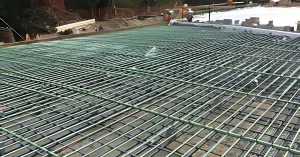Understanding the Unit Weight of GFRP Bars: A Comprehensive Guide
Glass Fiber Reinforced Polymer (GFRP) bars, more commonly referred to as rebars, are an increasingly popular material choice used for construction projects. Their advantages over steel include corrosion resistance, lightweight properties and increased tensile strength. In this guide we explore their unit weights, advantages vs steel bars comparison, price fluctuations in India as well as factors impacting their price in India – helping you understand why GFRP bars have become such an appealing alternative in modern construction projects.
What Is Glass Fiber Reinforced Polymer (GFRP)?
GFRP stands for Glass Fiber Reinforced Polymer and refers to a composite material composed of glass fibers reinforced by polymer resins that creates a material resistant to environmental and chemical corrosion, such as bridges, highways or marine structures where durability and longevity is crucial. GFRP bars can be seen used extensively across such applications as bridges highways marine structures as they offer excellent strength while remaining corrosion proof over their lifespans.
Key Properties of GFRP Bars
Lightweight: GFRP Bars are four times lighter than steel, making them easier to transport and handle.
High Tensile Strength: Although lightweight, these GFRP bars possess impressively strong tensile strengths comparable or surpassing that of steel.
Corrosion Resistance: GFRP bars offer superior corrosion resistance over steel products, making them suitable for environments exposed to moisture or chemicals.
Non-Magnetism/Non-Conduction: Because their electromagnetic interference-resistent property, these materials make GFRP an attractive option in projects where this may be an issue.
Understanding GFRP Bar Weight Construction
projects depend heavily upon their unit weight being appropriate; its weight directly affects design and structural integrity of projects. Steel bar units generally weigh more, so understanding their unit weights in relation to each other and other materials helps ease of transportation/handling issues and cost considerations when considering alternative construction materials like fiberglass reinforced polyester (GFRP) bars can provide significant cost-savings through reduced transportation/handling requirements and usage costs.
Calculating the Unit Weight
The unit weight of GFRP bars depends on their diameter and density. Typically, the density of GFRP material ranges from 1.8 to 2.1 g/cm³. To calculate the unit weight, use the following formula:
Unit Weight (kg/m)=π×Diameter24×Density\text{Unit Weight (kg/m)} = \frac{\pi \times \text{Diameter}^2}{4} \times \text{Density}
For example, for a GFRP bar with a diameter of 10 mm and a density of 1.9 g/cm³:
Unit Weight=3.1416×(0.01)24×1.9=0.0149 kg/m\text{Unit Weight} = \frac{3.1416 \times (0.01)^2}{4} \times 1.9 = 0.0149 \text{ kg/m}
This low unit weight makes GFRP bars a preferable choice for lightweight construction without compromising strength.
GFRP Bars vs. Steel Bars: A Comparative Analysis
Weight and Strength Won’t Spare Steel Bars in Comparison
Whilst both materials offer similar strength-to-weight ratios, GFRP bars tend to be lighter with greater transportability and installation ease; their increased corrosion resistance makes GFRP bars stand out. By comparison, Steel Bars tend to increase transportation and handling costs and handling expenses significantly
GFRP Bars: Do not rust, making them suitable for environments with high moisture or chemical exposure.
Steel Bars: Susceptible to corrosion and require additional protective coatings or maintenance for protection from further rust and corrosion.
Price Comparison
Although initial costs associated with GFRP bars may be greater than steel alternatives, their long-term advantages such as lower maintenance expenses and longevity make GFRP an economic choice.
Factors Affecting GFRP Rebar Price in India
Many different elements contribute to determining the price of GFRP rebars in India:
Raw Material Costs: Glass fiber and resin costs can have an outsized effect on prices, while advanced manufacturing technologies often result in both improved quality as well as higher production costs.
Market Demand: As demand for sustainable construction materials grows, so too may their costs. Import Duties and Taxes: Imported materials incur additional duties and taxes that affect their final price tag.
India boasts many reliable GFRP Rebar Manufacturers; one such is ES HAJI & CO who specialises in creating top-quality rebar products which meet international standards to guarantee long-term durability and performance.
Why choose ES HAJI & CO? Our products meet rigorous quality control measures to provide certified, tested GFRP products at competitive pricing compared to imported alternatives, while custom solutions can also be provided based on specific project needs.
Conclusion
GFRP bars provide an economical and sustainable alternative to steel rebars in many construction applications due to their lightweight nature, high tensile strength and corrosion resistance properties. Being aware of their unit weight can assist project management effectively while meeting sustainability and durability criteria in India’s infrastructure development plans.
For information regarding GFRP bar prices, properties and suppliers in India, reach out to ES HAJI & CO; one of Flange Manufacturers in Chennai.
GFRP Bars

Explore the unit weight, properties, and benefits of GFRP bars in India. Compare GFRP vs steel, and learn about GFRP rebar manufacturers and prices.
Product Brand: E S HAJI And CO
Product Currency: INR
Product Price: 100
Price Valid Until: 2024-12-31
Product In-Stock: InStock
5


